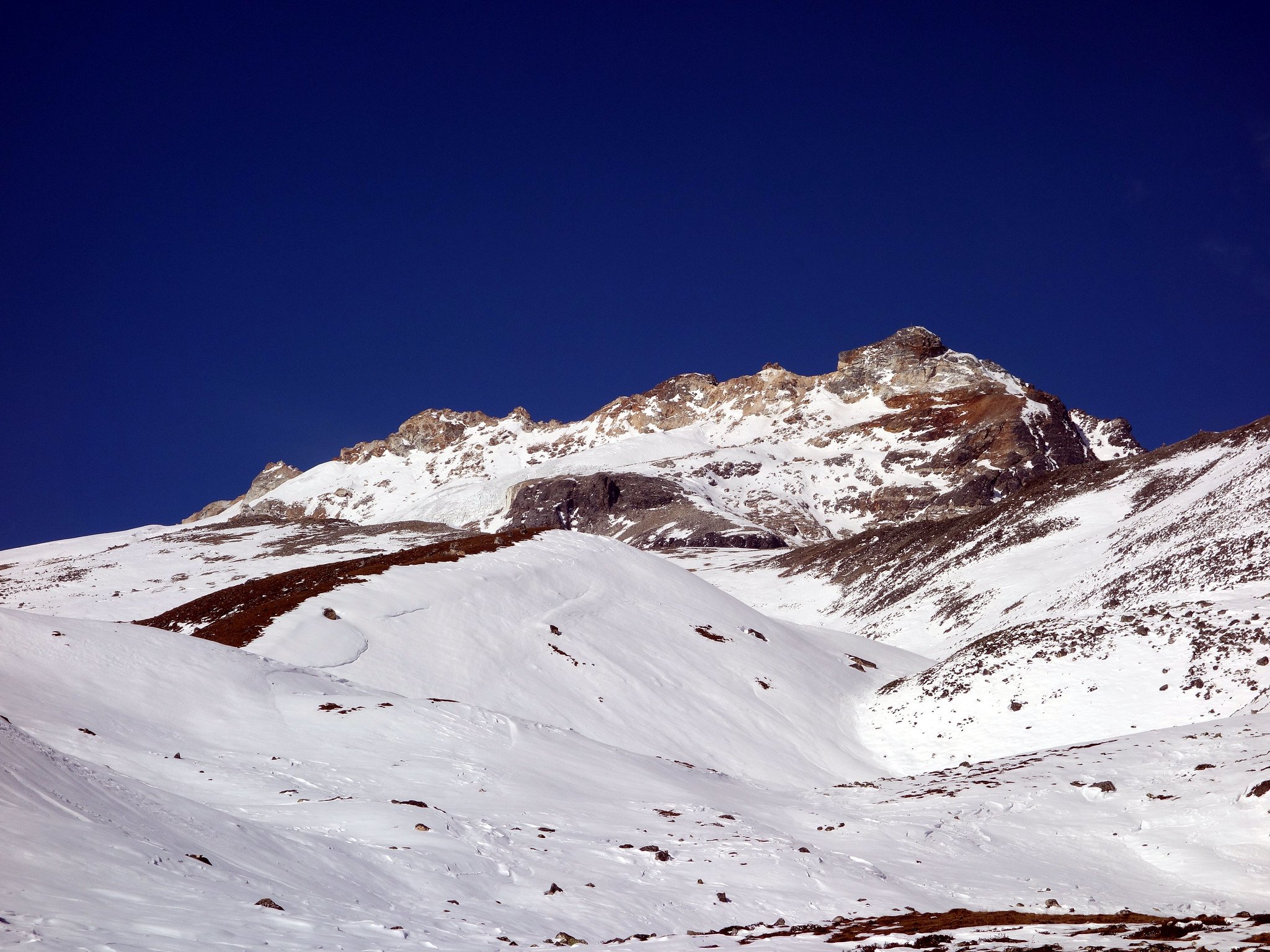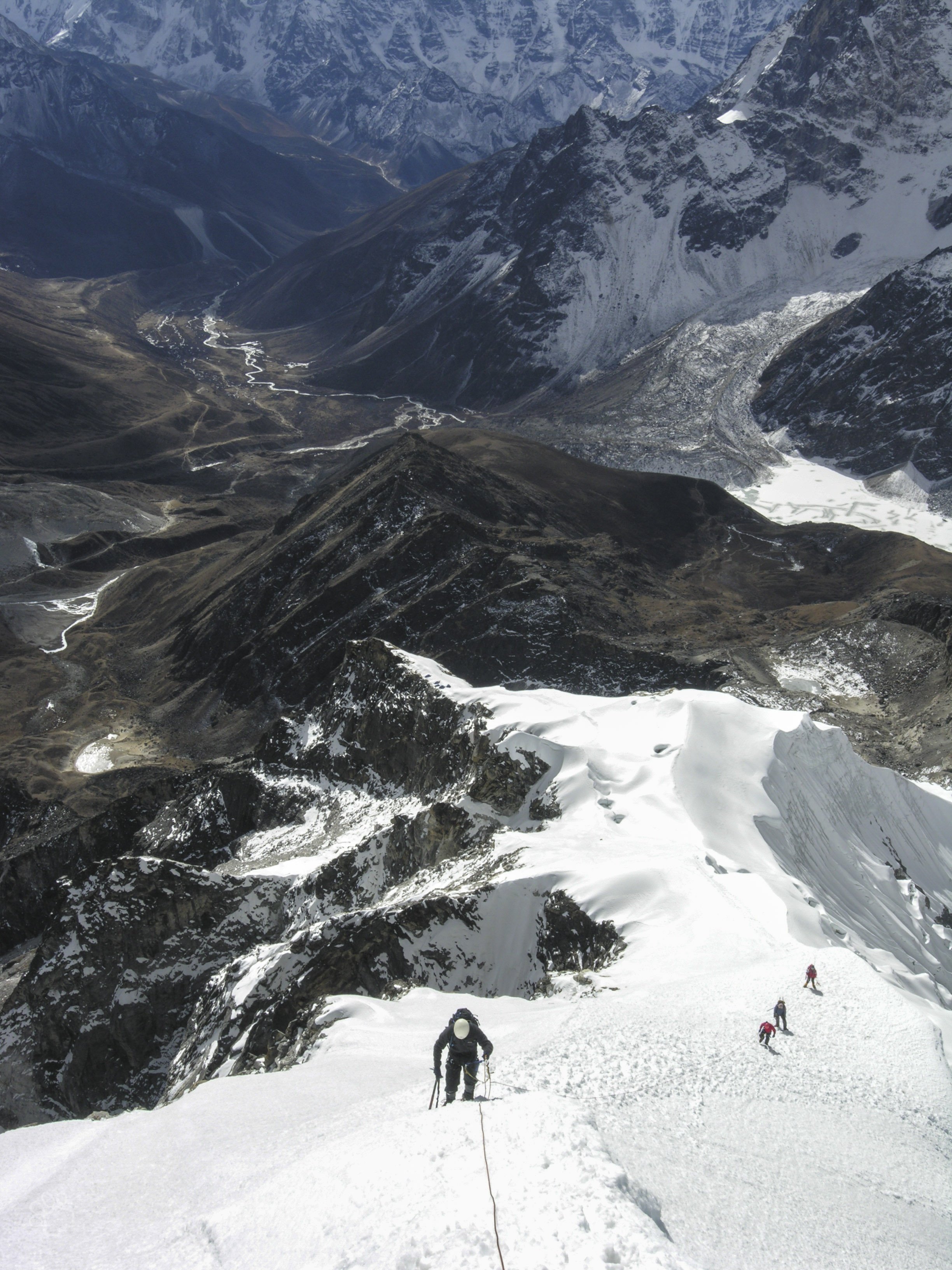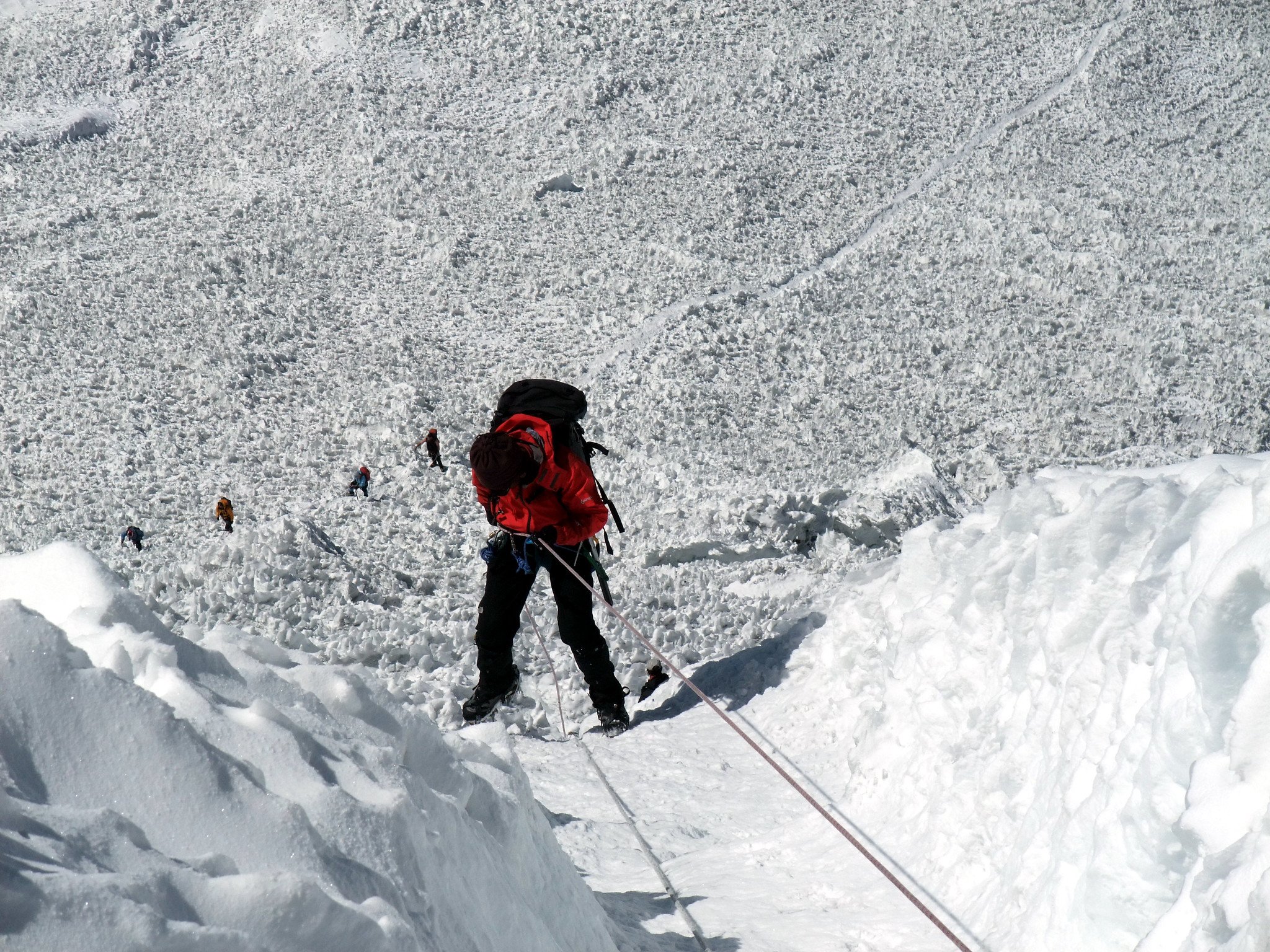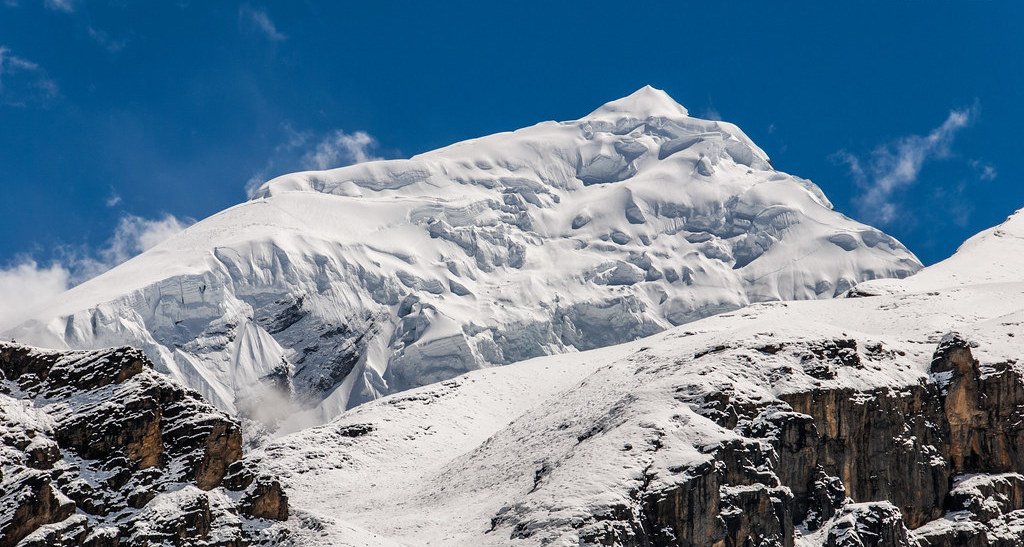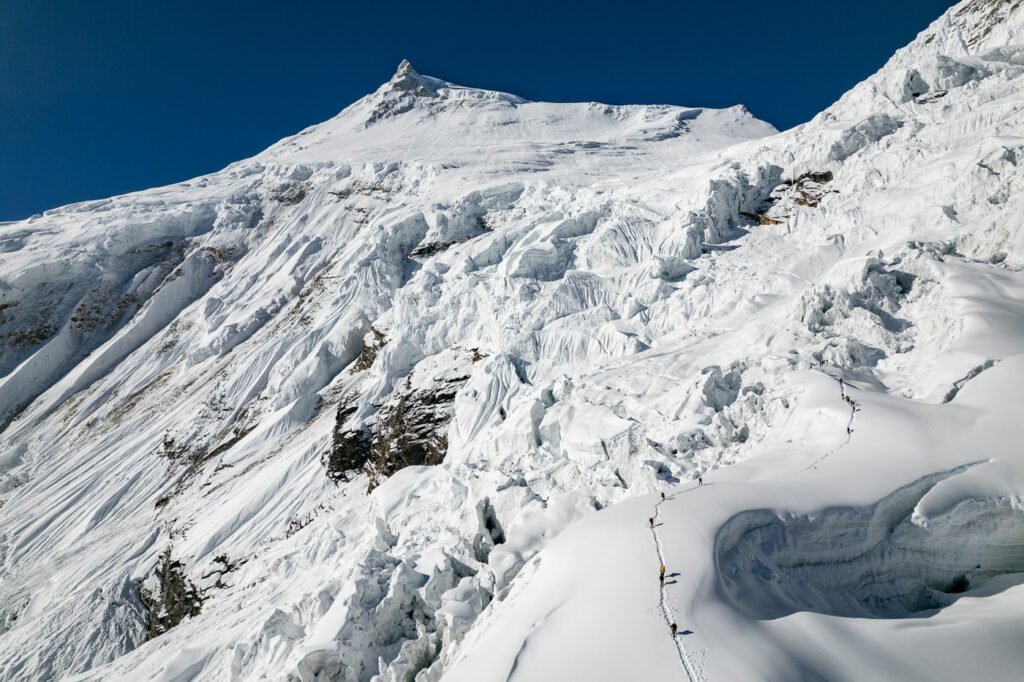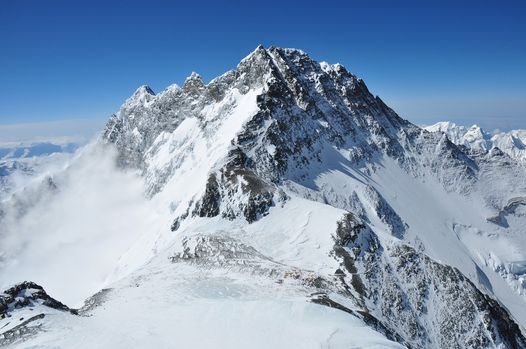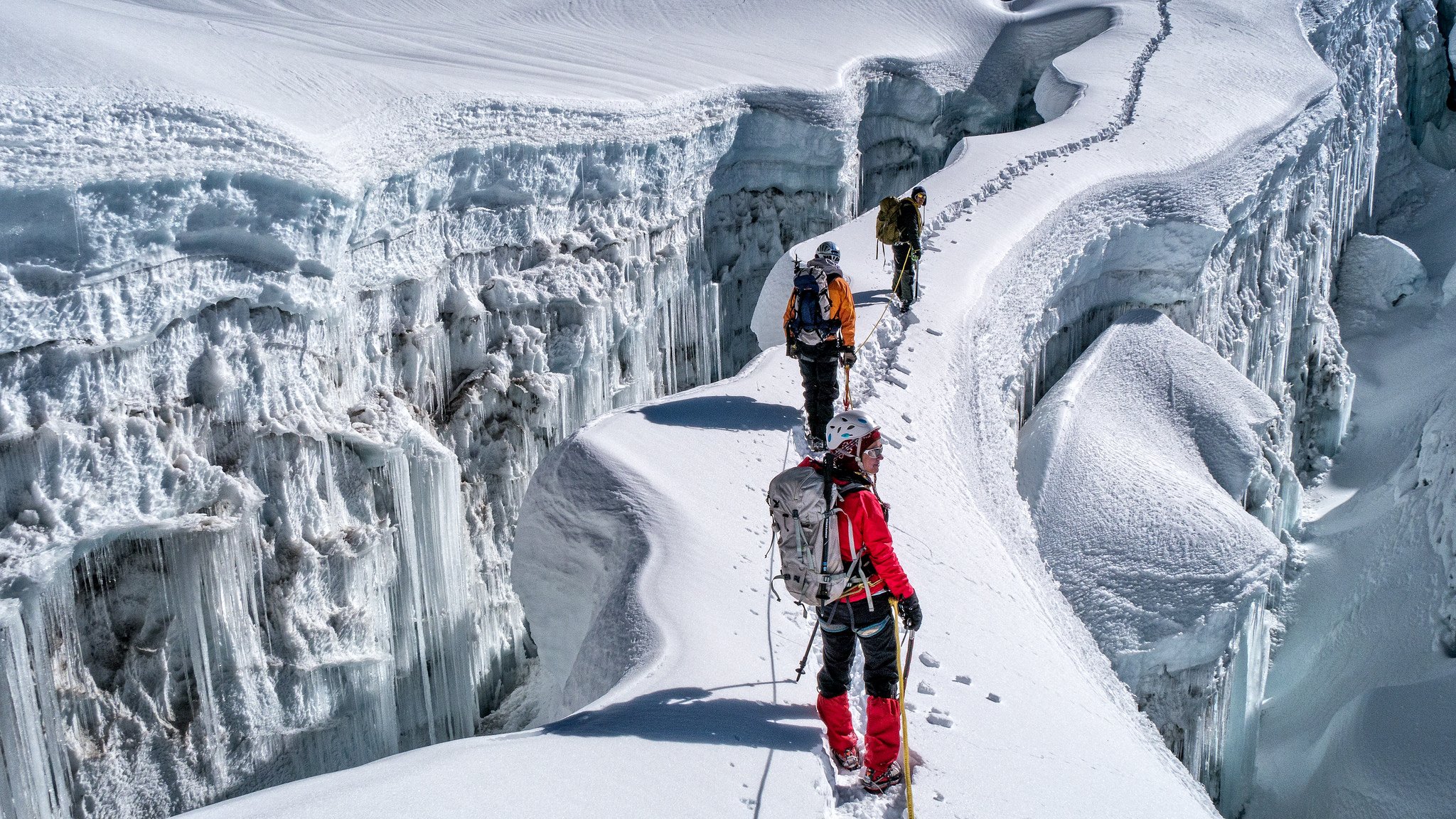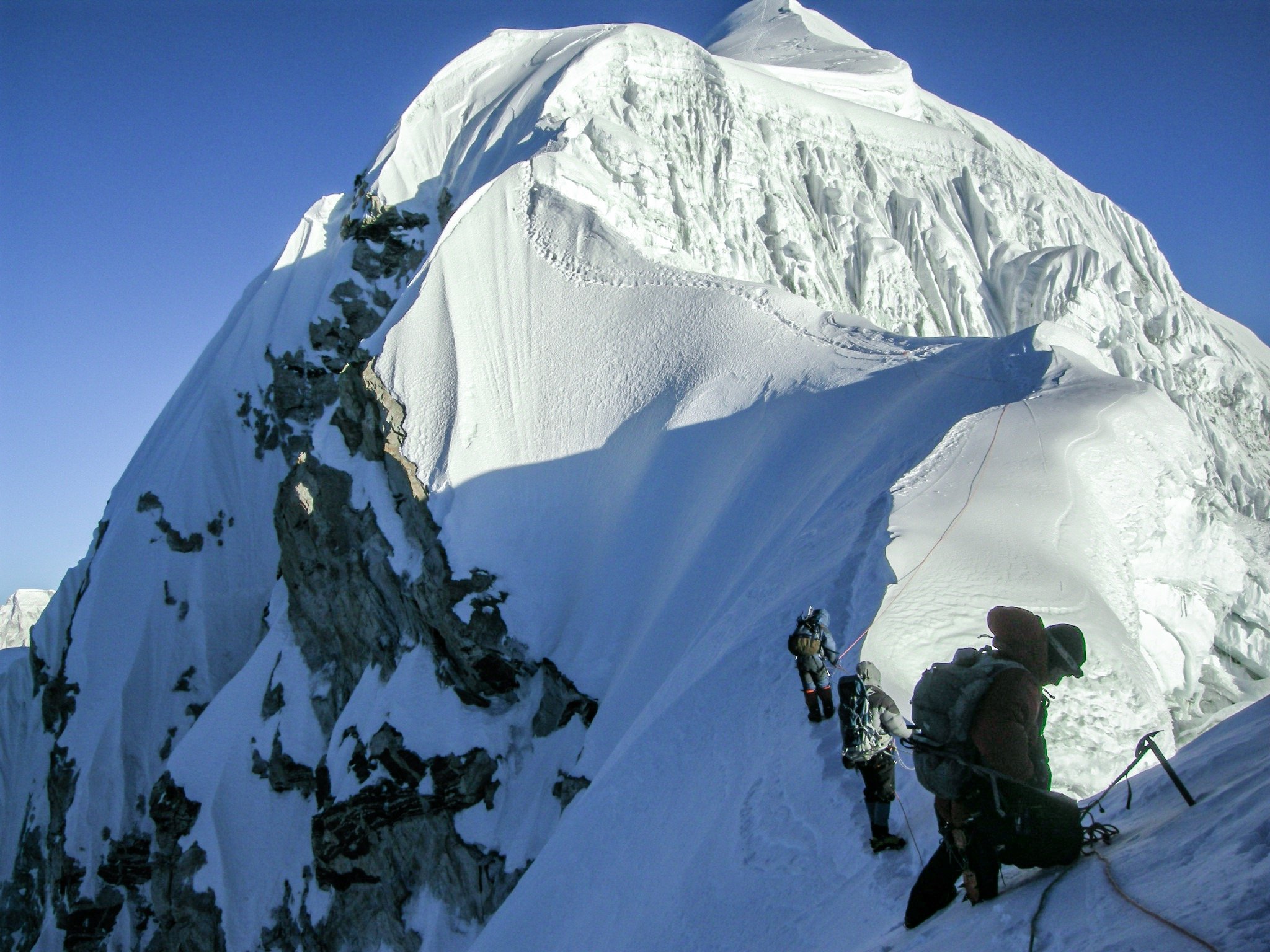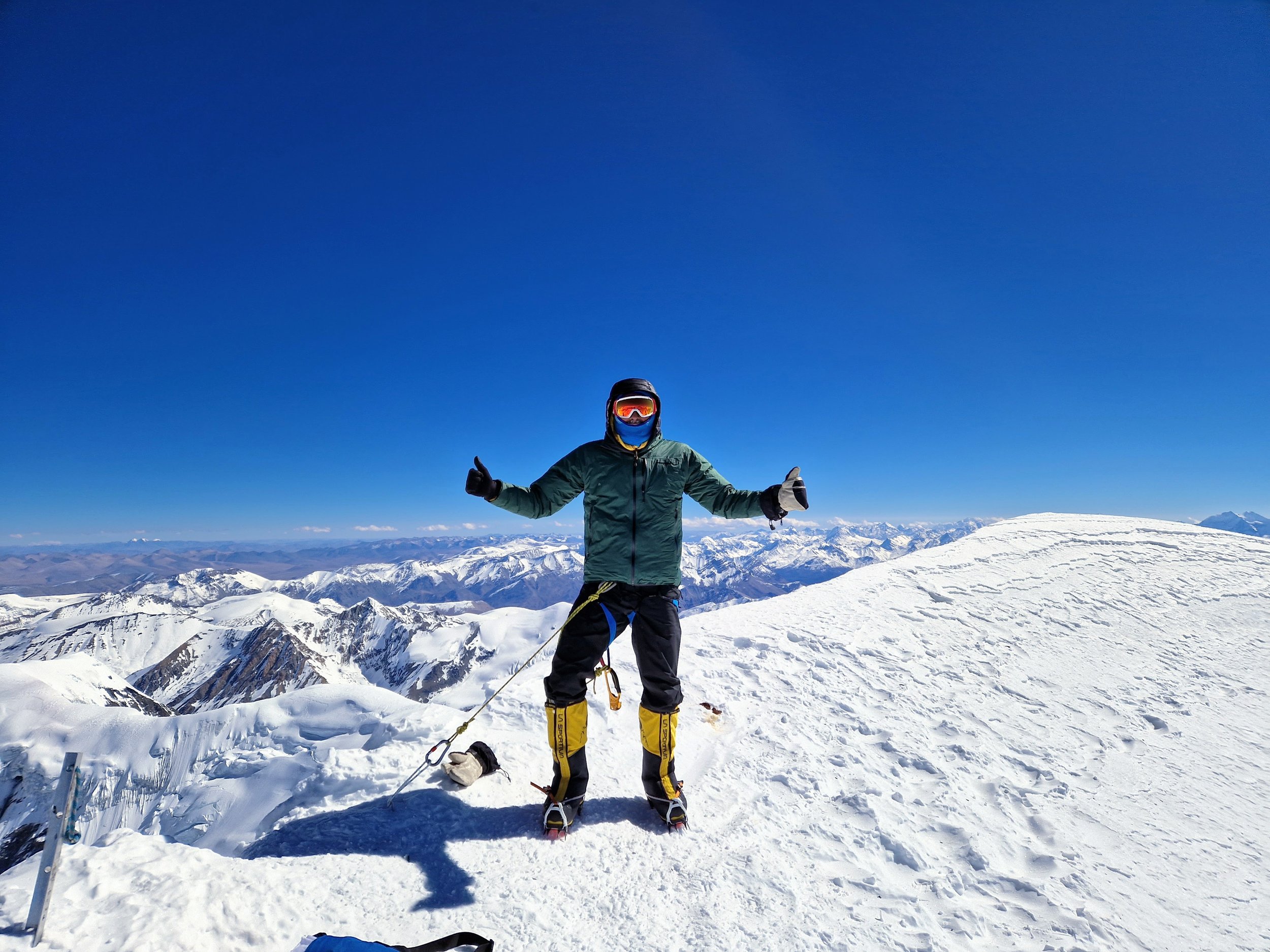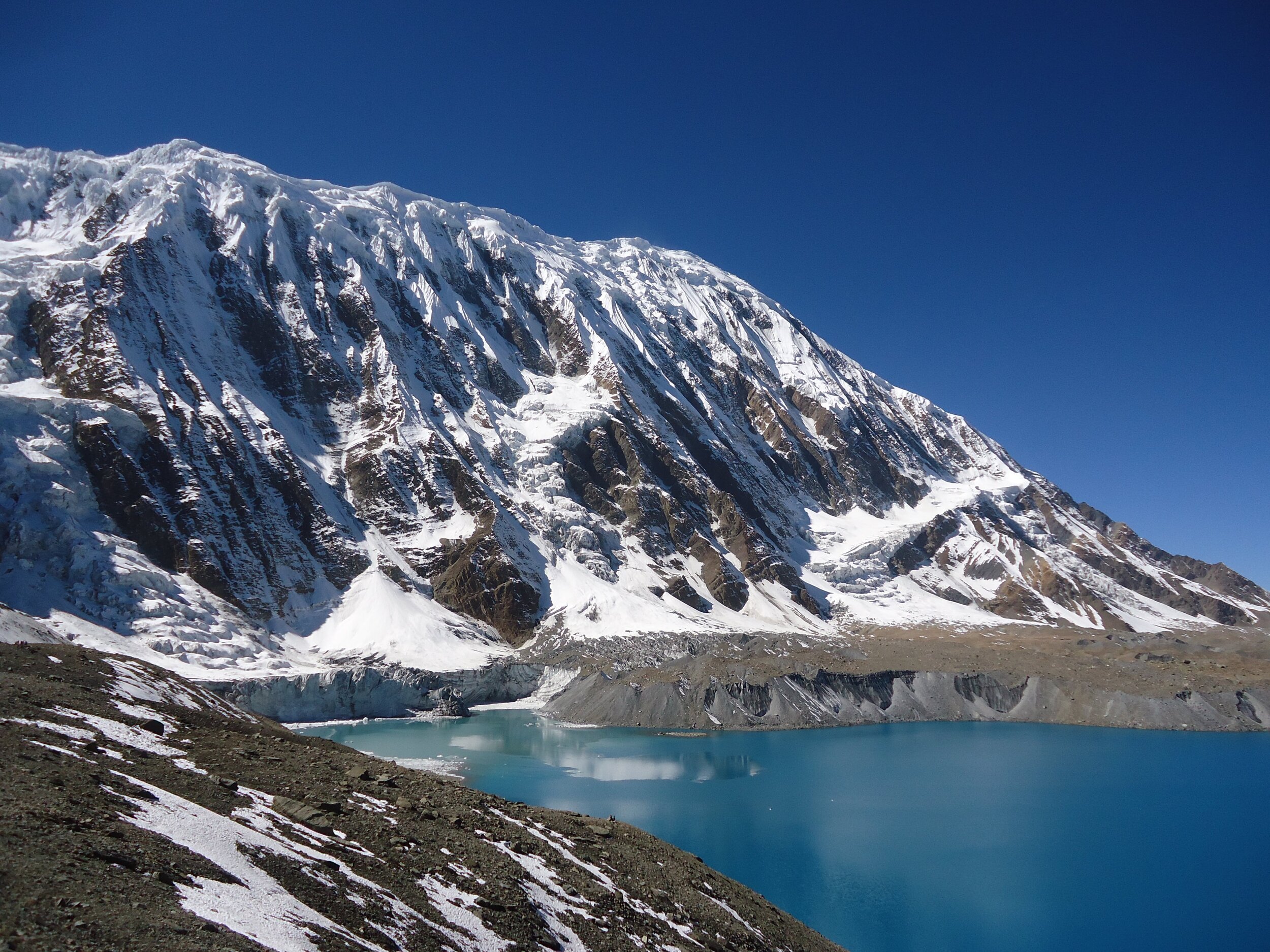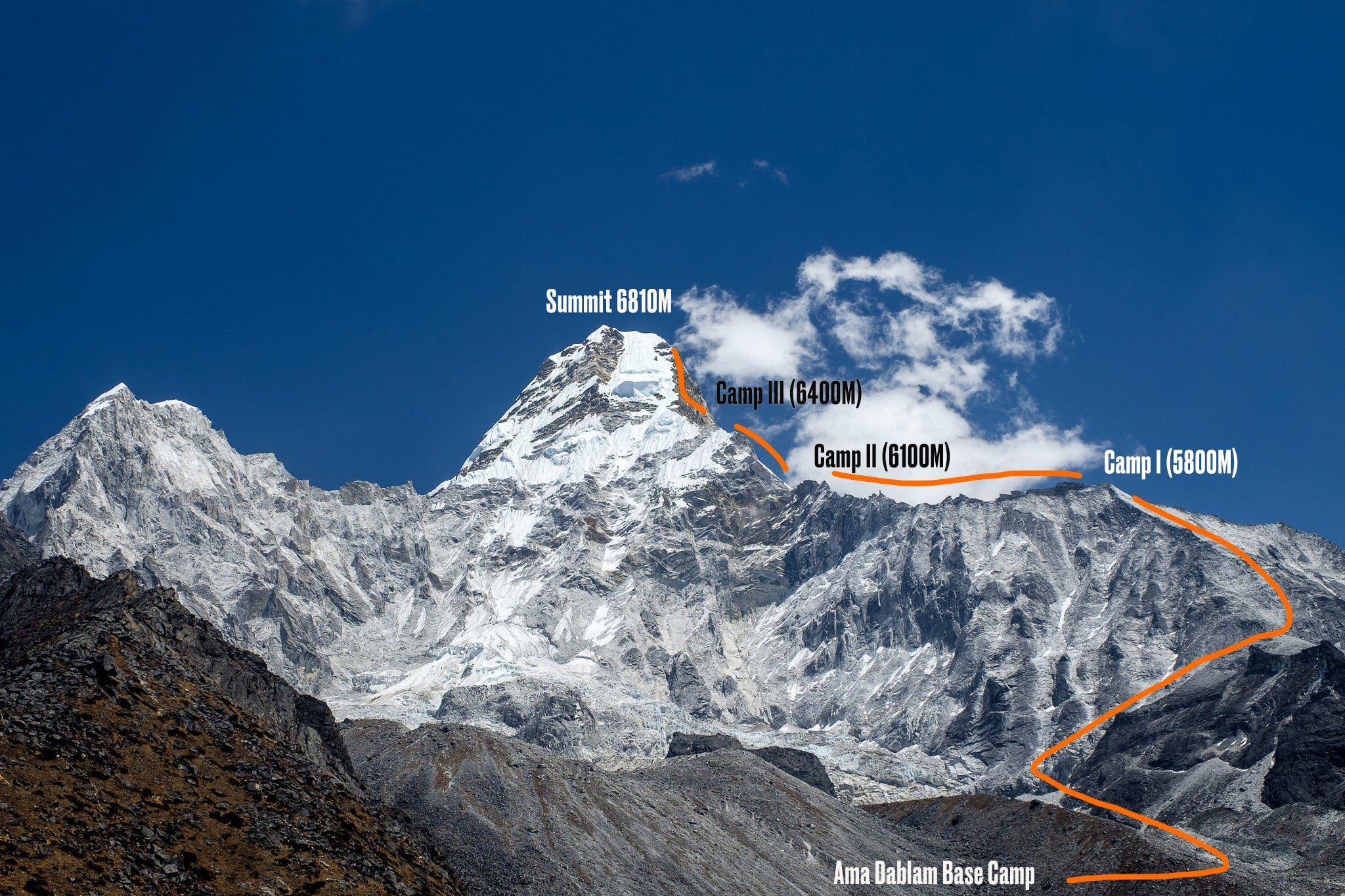How to prepare for Baruntse climbing expedition? - Namas Adventure
Planning your next 7000er expedition to Baruntse 7129M Peak? Your pre-requisite previous experiences of climbing 4000M - 6500M+ semi/technical peaks are a must. The climbing route in Baruntse is considerably safer and semi-technical in difficulty but like any high-altitude mountain expedition, you need to have a well-rehearsed understanding and the right experiences. The major technical crux is at the 6900M ridge leading to the summit. Be ready for an exposed climb.
In this blog article, we will recommend prerequisite expeditions that will help you to be ready for the Baruntse expedition. The journey of climbing Baruntse peak is for everyone. (Yes, even if you have summited Everest, K2, or other tougher peaks). Mountain climbers are in love with the process of climbing, the journey, and not just the summits. If you are a novice/beginner climber, you are a few years and expeditions away before taking on this amazing peak. For experienced climbers, once you assess our recommendations below, should this expedition satisfy your next mountaineering adventure, then please get in touch with our team as we plan the Baruntse climb every year. (Spring/autumn).
Baruntse Expedition is for intermediate+ to pro experience level climbers. Now you know what it takes to climb this 7000M mountain, let’s start with our step-by-step expedition recommendations.
Step 1 (Novice level to Beginner Level)
If you are an absolute beginner who has never been to any previous high-altitude adventures trekking or climbing and somehow you are inspired and dream of climbing Baruntse one day, then we can suggest these peaks, to begin with. With our team in Nepal, you can participate in our introductory expeditions to Introduction to Mountaineering - Yala Peak 5732M or Mera Peak 6476M to begin your mountaineering journey. This expedition’s objective will be to teach you the basics and fundamentals of mountaineering, test/expose yourself to any high-altitude environment on a non-technical peak climbing adventure in Nepal or around the world. You will have to be in a good shape (run 5K, 2-3 times a week coupled with strength sessions) and upon completion, this experience will give you the confidence to climb other higher and semi-technical peaks.
Expedition Outcomes
Introduction and learn the basics of mountaineering
Learn the basics or mountaineering from certified local guides
High altitude experiences
Fun times in the mountains
Step 2 (Beginner to intermediate level) Lobuche East & Island Peak
At this level, you should have been exposed to climbing in mountains. You have the understanding and experience on the fitness/mental level required during mountain expeditions. At the beginner to intermediate level, you will further learn climbing at high altitude with some technical pitch sections. Meaning you will be re-introduced to all the previous basic climbing skills adding further technical climbs. You will learn to navigate mixed rocky/snow/ice sections. Scrambling/traversing on exposed sections and jumaring on the fixed-line rope to take on vertical sections of the mountains.
These skills are very necessary as you progress on your mountaineering journey and expeditions of this type will give you that extra confidence to take on other tougher and technically challenging peaks in the Himalayas or around the world. We recommend peaks such as Island Peak 6189M + Lobuche East 6019M, Khumbu Three Peak Expedition, Chulu West 6419M, Three Peak Peru, expeditions for climbers at this stage. This expedition provides all the technical and physical challenges for climbers looking to progress at the Intermediate/+ level.
Expedition Outcomes
Introduction or Re-introduction to classic mountaineering climbs
Familiratisation with technical climbing gears
Climbing/scrambling/traversing in mixed section. (i.e- rock/ice/snow)
Experience climbing on exposed sections. (i.e. Ridge and couliors)
Jumaring in fixed-line to climb vertical sections.
Abseiling/Rappel several hundred feet down on fixed-line
Summits and small-scale expedition environment, tons of climbing fun
Step 3 (Intermediate to +/Advanced level)
At this stage, you are all ready for Baruntse 7129M Expedition. Like any mountaineering adventure, Baruntse climbing should not be underestimated. The climbing routes are well exposed starting around 6900M. With the assistance of your guide and attached to a fixed rope you will be climbing uphill on the ridge-cornice section for an extended period of time and lots of abseiling down. You will have to be mentally/physically ready and your confidence/experience is super key.
Expedition of this nature will test you, where all your previous knowledge of climbing/scrambling/traversing in the exposed mixed section will be put to test. There will be two high alpine camps and longer days at higher altitudes. You are constantly exposed to the forces of nature and mentally/physically you are challenged for an extended period of time compared to your previous expeditions. Baruntse expeditions will be longer, more demanding, tougher, and technically, physically, and mentally challenging than your previous climbs. You will also have to learn how to co-operate as a team, there may be some weak links in the team so you will have to adjust, and understand how grouped expedition runs, allowing everyone to achieve the same goal of summiting a 7000M peak, as well as developing their skills and experiences further to take on much more technically demanding and together peaks.
Expedition outcomes
Developing climbing skills at 7000M level.
Understanding of full expedition setups
Climbing/scrambling/traversing in mixed section. (i.e- rock/ice/snow) at higher altitudes above 6000M.
Longer exposure to climbing on exposed sections. (i.e. 6900M Ridge and steep couloirs)
Jumaring in fixed-line to climb vertical sections.
Abseiling/Rappel in longer and exposed ridge sections.
Testing your physical and mental ability and pure grit at extreme altitudes.
Summits and climbing moments at 7000M level
Bonus - Step 2. 1 even 8000ers or Pro level climbers (Grades TD+)
This is a bonus step. Many experienced climbers are attracted to the remoteness and challenge of climbing Baruntse Peak. Even after completing 8000er peaks like Everest, Manaslu, Makalu, K2, and Ama Dablam climbers return to enjoy the climb at this 7000M peak. So if you have done 8000M peaks then you are 100% qualified for Baruntse expedition. You will already have an understanding of big mountain expeditions and what it takes to climb challenging mountains.
Similarly, if you consider yourself a pro-level ice climber who can take on vertical 300M - 400M ice walls at higher altitudes (WI- 4 to WI- 5) then you are already set for Baruntse Expedition. Probably trying other challenging routes is more for climbers at this level. Why not try new projects and exciting high-altitude adventures?
Bonus for pro climbers - This peak has other 3 challenging routes so climbing those routes with your trusted partners is the one to explore.
Planning to climb Baruntse Peak 7129M? You do not have the right experiences or need help preparing for 7000M climbs? Our team is here to understand your goals and help you plan strategically with the right experiences. Please go through our Alpine /fitness grades (link) to understand the difficulty and climbing grades of Baruntse and other peaks. We hope the guidance and suggestion on this blog post have helped you to have an understanding of what it takes to climb Baruntse Peak. There are a lot of other factors when climbing any extremely high altitude technical peaks in the Himalayas. Our team can help you prepare in the best way gaining the right experience to complete your dream of climbing Baruntse 7129M peak.
How to prepare for Ama Dablam climbing expedition? Step by step recommendations- Namas Adventure
We get this particular question asked a lot. Climbing the famous and exquisitely beautiful Ama Dablam peak has been or will be a dream for many aspiring mountaineers. This prominent and beautiful peak full-fills the thrill of climbing a mountain that combines technical challenges, not at an extremely high altitude but 200M shy below to 7000M level but is not your average peak expedition. Lots of steep climbing, in rock/ice/snow and exposed sections. This climb is definitely a must climb for mountain climbers. How can one go on about climbing this beautiful giant peak in the Himalayas?
In this blog article, we will just share all the prerequisite experiences required. Whether you are a novice climber who happens to see Ama Dablam when trekking the iconic Everest region or in images or you are beginner climbers who want to aim higher technical peaks. If you are an intermediate or pro/advanced level climber, who is just looking for a great mountaineering adventure ideas. We will recommend the necessary prior expeditions to be able to successfully take on this amazing expedition.
Amadablam 6810M climb is not for novice, beginner, or intermediate experience level climbers. You will need to have a good solid experience of previous several 4000M, 6000M, 7000M or even 8000M peak climbing experiences. If you consider your alpine climbing level at advanced or pro level, who have climbed mostly below 4000M then, substantial experience of alpine style and technical climbing experiences are a must. Now you know this is not an easy mountain to climb let’s start with our step-by-step expedition recommendations.
Step 1 (Novice level to Beginner Level)
If you are an absolute beginner who has never been to any previous high altitude adventures trekking or climbing and somehow you are inspired and dream of climbing Ama Dablam one day, then we can suggest these peaks, to begin with. With our team in Nepal, you can participate in our introductory expeditions to Yala Peak 5032M, Mera Peak 6476M, or Mountaineering course - Level 1 to begin your mountaineering journey. This expedition’s objective will be to test/expose yourself to any high-altitude trekking or non-technical peak climbing adventure in Nepal or around the world. You will have to be in a good shape but these introductory peak expeditions will help you learn the basics and fundamentals, giving you that confidence to climb other higher and semi-technical peaks.
Expedition Outcomes
Introduction and learn the basics of mountaineering
High altitude experiences
Fun times in the mountains
Step 1. 1 (Beginner to intermediate level) Lobuche East & Island Peak
At this level, you should have been exposed to climbing in mountains. You understand the fitness/mental level required during mountain expeditions. At the beginner to intermediate level, you will further learn climbing at high altitude with some technical pitch sections. Meaning you will be re-introduced to all the previous basic climbing skills adding further technical climbs. You will learn to navigate mixed rocky/snow/ice sections. Scrambling/traversing on exposed sections and jumaring on the fixed-line rope to take on vertical sections of the mountains.
These skills are very necessary as you progress on your mountaineering journey and expeditions of this type will give you that extra confidence to take on other tougher and technically challenging peaks in the Himalayas or around the world. We recommend peaks such as Island Peak 6189M + Lobuche East 6019M, Khumbu Three Peak Expedition, Chulu West 6419M, Three Peak Peru, expeditions for climbers at this stage. This expedition provides all the technical and physical challenges for climbers looking to progress at the Intermediate/+ level.
Expedition Outcomes
Introduction or Re-introduction to classic mountaineering climbs
Familiratisation with technical climbing gears
Climbing/scrambling/traversing in mixed section. (i.e- rock/ice/snow)
Experience climbing on exposed section. (i.e. Ridge and couliors)
Jumaring in fixed-line to climb vertical sections.
Abseiling/Rappel several hundred feet down on fixed-line
Summits and small-scale expedition environment, tons of climbing fun
Step 2 (Intermediate to Intermediate + level)
At this level, you are now 1 step closer to the Ama Dablam expedition. Although it is tempting to climb Ama Dablam after your one or two 6000M+ semi-technical expeditions, we advise climbers not to rush into climbing Ama Dablam. Ama Dablam's climbing should not be underestimated. The climbing routes on Ama Dablam are super exposed, which requires an extended period on the fixed-line rope, climbing on a vertical-exposed ridge section, and lots of abseiling down. You will have to be mentally/physically ready and your confidence/experience is super key.
So any climbing expedition at 7000M+ level can be strategically fitted into your climbing plans to finally take on Ama Dablam. We highly recommend Baruntse 7129M, Himlung Himal 7126M Expedition, Tilicho Peak 7139M Expedition, Khan Tengri 7001M etc. These long days expeditions are semi-technical to technical climbs in nature with long and proper exposure to full expedition setup. Expedition of this nature will test you fully where all your previous knowledge of climbing/scrambling/traversing in the exposed mixed section will be put into test. There will be additional higher alpine camps and longer days at higher altitudes. You are constantly exposed to the forces of nature and mentally/physically you are challenged for an extended period of time compared to your previous expeditions. These expeditions will be longer, more demanding, tougher, and technically, physically, and mentally challenging. You will also learn about climbing in the team, how to co-operate as a team, assisting the weak links and how a grouped expedition runs, allowing everyone to achieve the same goal of summiting a 7000M peak as well as developing their skills and experiences further, to take on much more technically demanding and together peaks.
Expedition outcomes
Developing climbing skills at 7000M level.
Understanding of full expedition setups
Climbing/scrambling/traversing in mixed section. (i.e- rock/ice/snow) at higher altitudes above 6000M.
Longer exposure to climbing on exposed sections. (i.e. Ridge and steep couloirs)
Jumaring in fixed-line to climb vertical sections.
Abseiling/Rappel in longer and exposed ridge sections.
Testing your physical and mental ability and pure grit at extreme altitudes.
Summits and climbing moments at 7000M level
Step 3 To Ama Dablam 6810M
Finally, you should be ready for Ama Dablam climbing expedition. Our only advice would be not to make the long gap between your last major expedition and Ama Dablam expedition. Try to do Ama Dablam within a year after you have accomplished your Step 2 expedition. Or if you are climbing technically challenging peaks around the world then the advice will be otherwise. In this way, your mind and body are still well attuned to climbing and taking on the tolls of climbing challenging mountains.
With all the experiences you have gained from your last 2+ expeditions you should be now ready with your technical ability, physically and mentally. Of course, as a mountain climber, you are training once you are back home and rested.
Amadablam is a climber’s mountain. Additionally to your minimum experiences which we have recommended above, you will need to be very proficient with the set of skills mentioned below and you will need exceptional physical fit. Clients are responsible to carry their own back pack (5-10kgs) once they leave base camp. Sherpa guide expedition leader will guide and motivate you throughout but a lot of the effort lies within you and your ability to climb. Must have skill sets -
Rock climbing indoors and outdoors - (i) learn the basics of wearing harness and helmets (ii) tying figure 8 knot and stopper knot (iii) basics of using the belaying device correctly (iv) Use ascending and descending devices (iv) basics of using ropes, start/end when climbing (v) learning knowledge of moving while using the gears and being checking the safety features simultaneously.
Regularly rock climbing up to 5.10 a,b,c +. The more experience you have in rock climbing, taking on tougher routes in different types of rock, the better it is for you to get familiar with the climbing style and adjust during the expeditions.
Abseiling. This is the simplest yet, one of the most important skills to master. Some multi-pitch abseiling knowledge/experience is also required. Be prepared to descend down for a long duration from the summit to camp 2 or 1.
Climbing on different terrains. Slab rocks, vertical rocks. Scrambling on steep terrains.
Use of Crampons and Ice axe. Winter ice climbing or mountaineering courses are recommended. If you are particularly keen on climbing during the spring season, ice climbing skills up to WI-3 or WI-4 are required. During the autumn season climb, it is less likely you will be needing ice climbing skills. You should be able to kick step and balance with an ice axe on icy slopes to ascend on the vertical climbs. Ice arrest skills to save yourself in case of slips or falls, being comfortable while descending and abseiling with crampons in all types of terrains.
Understanding how your body adjusts when climbing in Altitude. We will be climbing Island peak as a training/acclimatising peak. Your prior experience in climbing should give you a good understanding of how your body copes at high altitudes. You are responsible to build your fitness up to the best level. Our itineraries are designed to be able to help you with proper acclimatisation. Equally important clients have to be aware of their eating patterns and stay hydrated.
Expedition outcomes
Further developing technical climbing skills at 6200M to 6800M level. Ready to take on higher or technical peaks.
Understanding of full expedition setups
Climbing/scrambling/traversing in mixed section. (i.e- rock/ice/snow) at higher altitudes above 6000M.
Longer exposure to climbing on exposed sections. (i.e. Ridge and steep couloirs)
Jumaring in fixed-line to climb vertical sections.
Abseiling/Rappel in longer and exposed ridge sections.
Testing your physical and mental ability and pure grit at extreme altitudes.
Summits, uncountable memories, and further confidence to take on higher technical peaks.
Bonus - Step 2. 1 even 8000ers or Pro level climbers (Grades TD+)
This is a bonus step. Many experienced climbers are attracted to the beauty of Ama Dablam. Even after completing 8000er peaks like Everest, Manaslu, Makalu, K2 climbers return to enjoy the climb at Ama Dablam. So if you have done 8000M peaks then you are qualified for Ama Dablam expedition. You will already have an understanding of big mountain expeditions and what it takes to climb challenging mountains.
Similarly, if you consider yourself a pro-level climber who can take on vertical 300M - 400M ice walls at higher altitudes then you are already set for Ama Dablam. Probably trying other challenging routes is more for climbers at this level. Why not try new projects and exciting feats in Ama Dablam. This peak has other 10 challenging routes so climbing those routes with your trusted partners is the one to explore. If you similarly want to join our yearly expeditions then please do inquire and join our team during Spring, when there are fewer climbers or during the late autumn then our team can organize an expedition for your group.
Are you planning to climb Ama Dablam Expedition? What is your experience level? Please go through our Alpine /fitness grades (link) to understand the difficulty and climbing grades of Ama Dablam and other peaks. We hope the guidance and suggestion on this blog post have helped you to have an understanding of what it takes to climb Ama Dablam. There are a lot of other factors when climbing any extremely high altitude technical peaks in the Himalayas. Our team can help you prepare in the best way gaining the right experience to complete your dream of climbing Ama Dablam 6810M peak.
Go challenge greater things. Commit and finally take on that dream adventures you have always been planning. Life is too short to live with regrets. See you in the mountains. 🙂🏔🙏🏼
Namas Adventure Team
Live Your Story



